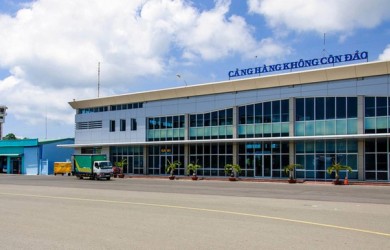Cong Quan House
The front entrance of Cong Quan House looks over the Southeast of the sea, the rear is adjacent to Ton Duc Thang Street to its Northwest, the right side borders a coast to the Northeast, and the left side is adjacent to the Net Department to the Southwest.
Cong Quan House, which is located next to the pathway to Tau Bridge, is a Western-style house that modestly nestles under the big canopy of old terminalia catappages. The house has changed a lot compared to its original form: most of the wooden doors have been replaced with glass doors, the arch system has been replaced with square frames, bricks and glazed tiles have been replaced with cement. On the wall facing the beach, there is a 40 cm square bronze sign, boldly engraved a phrase: “Dans cette maisson vécut le grand compositeur Camille Saint Saens du 20 Mars au 19 Avril 1895, l’y ahceva l’opera Brunehilda”. There is nothing left inside the house, even the bronze sign has been removed, leaving only the wooden frame on the wall.

This is a guest house (Maisson de passeger) built in the late 19th century, later called the Public House (Cong Quan) in the American Erawhich served as a stopping place for the officers when they came here on duty. In 2006, this relic was restored as the current guest house. Cong Quan House is currently a historical relic commemorating the world-famous individual (foreigner) that used to live in our country. It was the famous French musician Charles Camille Saint Saens who stayed here for one month, from March 20 to April 19, 1895. During that time, he completed the famous musical Brunehilda. Charles Camille Saint Saens (1835- 1921) came here thanks to an invitation of his old friend Rousseau who was newly appointed to be the Governor-General of Indochina. Perhaps after witnessing the writhing pain of prisoners working under the sun and mingling with the color of the wonderful sea of Con Lon, he experienced intense emotions and finished the masterpiece melody in the last chapters of Brunehilda musical which was commissioned by his deceased friend – musician Guirand.
On the night of April 19, 1895, he stayed up all night in Cong Quan House, finished the last chapters of that musical, and save his concerns in a letter sent to Jacquet before leaving the island:
“… The landscape of Con Lon is spectacular. I have never seen such beauty considering all the places I have been to, whether in Spain, Canari, Egypt, Seychelles, or Algeria. Or maybe it is because I have come here thanks to my friend. . I am now pleased that here, I have completed the final three chapters of the opera Brunehilda, fulfilling Guirand’s last words”.
“I regret that I do not know much about the people, the culture, and the music of this country. But what I felt here had enriched my musical feelings, making me believe that this music has reflected the beauty, the benevolence, the richness in the soul of these local people. They are suffering a lot!”.
“ … As an artist, I firmly believe that: Crime will be repelled wherever beauty is respected, and law is no longer needed there”
That is the only beautiful impression of civilized France on this prison island. Other impressions belong to colonial France.

This is a guest house (Maisson de passeger) built in the late 19th century, later called the Public House (Cong Quan) in the American Erawhich served as a stopping place for the officers when they came here on duty. In 2006, this relic was restored as the current guest house. Cong Quan House is currently a historical relic commemorating the world-famous individual (foreigner) that used to live in our country. It was the famous French musician Charles Camille Saint Saens who stayed here for one month, from March 20 to April 19, 1895. During that time, he completed the famous musical Brunehilda. Charles Camille Saint Saens (1835- 1921) came here thanks to an invitation of his old friend Rousseau who was newly appointed to be the Governor-General of Indochina. Perhaps after witnessing the writhing pain of prisoners working under the sun and mingling with the color of the wonderful sea of Con Lon, he experienced intense emotions and finished the masterpiece melody in the last chapters of Brunehilda musical which was commissioned by his deceased friend – musician Guirand.
On the night of April 19, 1895, he stayed up all night in Cong Quan House, finished the last chapters of that musical, and save his concerns in a letter sent to Jacquet before leaving the island:
“… The landscape of Con Lon is spectacular. I have never seen such beauty considering all the places I have been to, whether in Spain, Canari, Egypt, Seychelles, or Algeria. Or maybe it is because I have come here thanks to my friend. . I am now pleased that here, I have completed the final three chapters of the opera Brunehilda, fulfilling Guirand’s last words”.
“I regret that I do not know much about the people, the culture, and the music of this country. But what I felt here had enriched my musical feelings, making me believe that this music has reflected the beauty, the benevolence, the richness in the soul of these local people. They are suffering a lot!”.
“ … As an artist, I firmly believe that: Crime will be repelled wherever beauty is respected, and law is no longer needed there”
That is the only beautiful impression of civilized France on this prison island. Other impressions belong to colonial France.
Source: Department of Culture and Sport of Ba Ria-Vung Tau Provice, Photo: Internet
Newer articles
Older articles

















